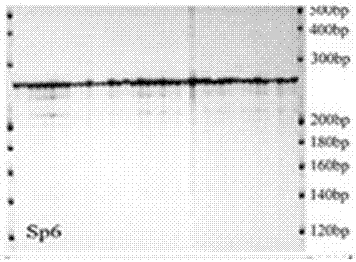Method for detecting spirodela polyrrhiza Sp6 microsatellite marker by means of specific primers
A technology of microsatellite marker and purple-backed duckweed, which is applied in the fields of biochemical equipment and methods, and the determination/inspection of microorganisms, and achieves the effects of fast speed, simple method, high accuracy and sensitivity
- Summary
- Abstract
- Description
- Claims
- Application Information
AI Technical Summary
Problems solved by technology
Method used
Image
Examples
Embodiment 1
[0028] Such as figure 1 As shown, the method for detecting the Sp6 microsatellite marker using specific primers is as follows:
[0029] 1) Material pretreatment: collect duckweed samples, domesticate, package, dry and set aside;
[0030] 2) Genomic DNA extraction of Duckweed: a. Preheat the CTAB extract solution in a water bath; b Grind the sample and transfer it to a centrifuge tube, add the extract solution, keep warm, and mix evenly by inversion; c Centrifuge, take the supernatant; d Add phenol / chloroform, mix well, centrifuge, take supernatant; e add chloroform, mix well, centrifuge, take supernatant; f repeat d, e 1~2 times; g add isopropanol, mix well, precipitate, centrifuge , discard the supernatant; h rinse the precipitate with ethanol, centrifuge, and discard the supernatant; i repeat h; j detect, store at low temperature, and set aside;
[0031] 3) Design specific primers:
[0032] Microsatellite Sp6-specific primer: F: GAACCTTAATATGCGACCAAG
[0033] R: CAAGAAAG...
Embodiment 2
[0046] Such as figure 1 As shown, the method for detecting the Sp6 microsatellite marker using specific primers is as follows:
[0047] 1) Material pretreatment: collect duckweed samples, domesticate, package, dry and set aside;
[0048] 2) Genomic DNA extraction of Duckweed: a. Preheat the CTAB extract solution in a water bath; b Grind the sample and transfer it to a centrifuge tube, add the extract solution, keep warm, and mix evenly by inversion; c Centrifuge, take the supernatant; d Add phenol / chloroform, mix well, centrifuge, take the supernatant; e add chloroform, mix well, centrifuge, take the supernatant; f repeat d, e preferably once; g add isopropanol, mix well, precipitate, centrifuge , discard the supernatant; h rinse the precipitate with ethanol, centrifuge, and discard the supernatant; i repeat h; j detect, store at low temperature, and set aside;
[0049] 3) Design specific primers:
[0050] Microsatellite Sp6-specific primer: F: GAACCTTAATATGCGACCAAG
[005...
Embodiment 3
[0064] Such as figure 1 As shown, 1) plant material collection: use ordinary fishing nets to collect Duckweed samples from natural waters such as rivers, ponds, ditches, and paddy fields, and the minimum interval between samples is 20m. The collected fresh Duckweed is first domesticated in the laboratory using tap water for 3-5 days, and then 20-40 Duckweed plants (including roots) with connected leaves are selected as genomic DNA extraction samples, that is, a clone. Each sample was individually packaged in a paper sample bag and dried with silica gel to prepare a dry sample.
[0065] 2) DNA extraction of Duckweed Genome: The modified CTAB method was used for DNA extraction, and 0.5 g of leaves were taken from each sample for DNA extraction.
[0066] a) Preheat the CTAB extract in a 65°C water bath;
[0067] b) Grind the sample quickly in liquid nitrogen, transfer the powdered material into a 2mL centrifuge tube, add preheated CTAB extract (3-5ml of extract per gram of samp...
PUM
 Login to View More
Login to View More Abstract
Description
Claims
Application Information
 Login to View More
Login to View More - R&D
- Intellectual Property
- Life Sciences
- Materials
- Tech Scout
- Unparalleled Data Quality
- Higher Quality Content
- 60% Fewer Hallucinations
Browse by: Latest US Patents, China's latest patents, Technical Efficacy Thesaurus, Application Domain, Technology Topic, Popular Technical Reports.
© 2025 PatSnap. All rights reserved.Legal|Privacy policy|Modern Slavery Act Transparency Statement|Sitemap|About US| Contact US: help@patsnap.com

